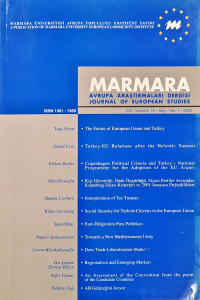Öz
Since the ancient times of Greece up to the VII Century A.D. the Mediterranean world has been characterized by a strong unity. Along the centuries the centre of this civilisation shifted from Athens to Rome and then to Constantinople. In the I century B.C., the Mediterranean became a Roman lake. The "Pax Romana" added the political and economic dimension to the Mediterranean unity. Later on, with the gradual spread of Christianity, the religious dimension also constituted a fundamental element of the Mediterranean civilisation. However the birth and diffusion of the Islamic religion caused the end of this unity and turned the Mediterranean Sea, which had been for centuries the centre of Christianity, the frontier oftwo hostile religions and civilisations. The collapse ofthe Mediterranean unit marks the beginning o f thirteen centuries o f hostilities and wars between the North and the East and South ofthe Mediterranean Sea. In the three last decades of the XX Century, mainly as a consequence of the development of the European construction, the relations between Europe and East and South Mediterranean countries changed deeply. Confrontation and search for hegemony came to an end, substituted by cooperation and partnership, the most meaningful moment being the Barcelona agreement of 1995. The Barcelona participants undertook to create a Euro-Mediterraneanfree trade zone embracing some 35 countries by the year 2010, including the present candidate countries. The Eu intends to achieve this objective by means of bilateral agreements known as Euro-Mediterranean Agreements (Ema). The Ema goes far beyond the economic sector, to include political and cultural dialogue. The Ema represent an outcome and a logic consequence of the process o f mutual understanding which constitute a basic characteristic o f the European integration. This principle once transferred to the external relations is determining deep transformations. Hegemony has thus been set out and substituted with the far more reaching concept of "partnership", having as a base the respect of each other's culture.
Anahtar Kelimeler
Kaynakça
- -
Öz
Since the ancient times of Greece up to the VII Century A.D. the Mediterranean world has been characterized by a strong unity. Along the centuries the centre of this civilisation shifted from Athens to Rome and then to Constantinople. In the I century B.C., the Mediterranean became a Roman lake. The "Pax Romana" added the political and economic dimension to the Mediterranean unity. Later on, with the gradual spread of Christianity, the religious dimension also constituted a fundamental element of the Mediterranean civilisation. However the birth and diffusion of the Islamic religion caused the end of this unity and turned the Mediterranean Sea, which had been for centuries the centre of Christianity, the frontier oftwo hostile religions and civilisations. The collapse ofthe Mediterranean unit marks the beginning o f thirteen centuries o f hostilities and wars between the North and the East and South ofthe Mediterranean Sea. In the three last decades of the XX Century, mainly as a consequence of the development of the European construction, the relations between Europe and East and South Mediterranean countries changed deeply. Confrontation and search for hegemony came to an end, substituted by cooperation and partnership, the most meaningful moment being the Barcelona agreement of 1995. The Barcelona participants undertook to create a Euro-Mediterraneanfree trade zone embracing some 35 countries by the year 2010, including the present candidate countries. The Eu intends to achieve this objective by means of bilateral agreements known as Euro-Mediterranean Agreements (Ema). The Ema goes far beyond the economic sector, to include political and cultural dialogue. The Ema represent an outcome and a logic consequence of the process o f mutual understanding which constitute a basic characteristic o f the European integration. This principle once transferred to the external relations is determining deep transformations. Hegemony has thus been set out and substituted with the far more reaching concept of "partnership", having as a base the respect of each other's culture.
Anahtar Kelimeler
Kaynakça
- -
Ayrıntılar
| Birincil Dil | İngilizce |
|---|---|
| Bölüm | Makaleler |
| Yazarlar | |
| Yayımlanma Tarihi | 28 Haziran 2002 |
| Yayımlandığı Sayı | Yıl 2002 Cilt: 10 Sayı: 1 |


